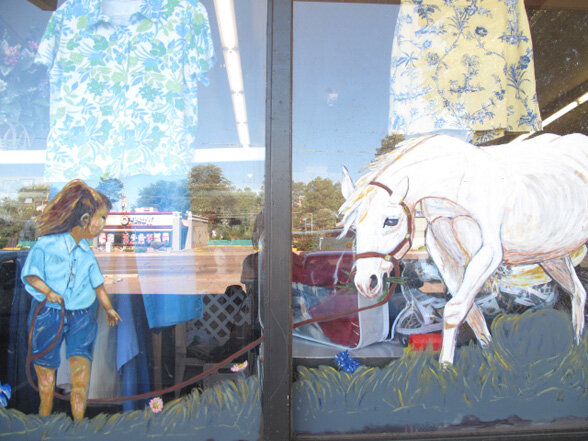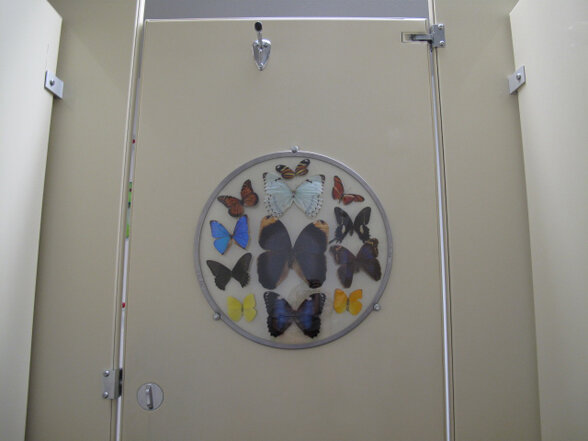I'M LOOKING THROUGH YOU
So I am sitting in the eye doctor's office on Monday, waiting to be seen, and the wait is taking a very long time. I have been sitting for more than an hour and a half. I had anticipated a long wait, so I brought a copy of the New Yorker. I remember not really liking the New Yorker, back when I lived in a tiny town and nothing that happened outside of it mattered to me. I thought of it as being written for other people. My best friend back then worked in a cabinet shop, and she said that she would read New Yorker while sitting on the toilet at the shop, and that she actually found it interesting. This struck me, and echoed in my head for a long time. (I can imagine her now, in that tiny shop bathroom, sitting on the toilet a few extra minutes before going back to work.) Years later, I finally decided to try reading the magazine, and was surprised by how exciting it can be to read about subjects I don't already know about. It's such an interesting process, learning. I think it might be as amazing as they say.The article I was reading in the doctor's office was a profile of the german artist, Thomas Struth. He makes large scale photographs, and he recently made an official portrait of Queen Elizabeth and Prince Philip. I found him an interesting subject. I was enjoying the article, except for the fact that I found the writer's style to be awfully intrusive and jarring. She didn't just write about Struth and his process, she kept inserting herself into the story as a character in the action. She writes about a conversation between herself and Struth, and she quotes herself cutting him off and finishing his sentences for him. "Who IS this woman?!," I thought. I entertained a fantasy of writing a letter to the New Yorker, saying something like, "I don't know who this Janet Malcolm is, but she sucks!" I had an electronic device in my bag, and I could have used it to write an email to the magazine right then and there, but instead I decided to look Janet Malcolm up and see if I could find any clues about why her writing was so annoying, or maybe find some commentary by other readers who have been similarly irritated.With a small amount of searching, I found two interviews with Janet Malcolm that made it clear to me that she is an utterly fascinating person, and that I have a lot to learn from her. I also could tell that she was someone about whom I really should have already known (possibly if I hadn't spent so many years ignoring the unknown). To summarize her very long and distinguished career, she is a journalist in her late seventies, who has written many books and articles about journalism itself, and other processes through which people attempt to uncover a picture of the truth, such as court trials and the writing of biographies. Her main theme appears to be the ways in which stories become distorted in their retelling. In 1990, as the opening lines to her book The Journalist and The Murderer, Malcolm wrote, "Every journalist who is not too stupid or too full of himself to notice what is going on knows that what he does is morally indefensible.” This quote was received as a betrayal by the journalistic community back then, and it took me a minute to digest it even now. I understand it to mean that journalists assume a sort of authority in writing about their subjects, and as a reader it's easy to accept that authority, digesting whatever flavor or bias the writer uses to present the information. She was calling out the fact that information isn't necessarily trustworthy once it's been filtered through a writer's perception. The fact that this idea seems fairly obvious to me is certainly evidence of how ahead of her time she was in calling it out. She was basically shunned by the literary establishment when her book was released, but over time her idea has become common knowledge, and her book is required reading for journalism students. In researching her further, it seems that throughout her writing she is carving out this vision about the magnitude of information that exists in the world, and the impossibility of ever reproducing it accurately. I am on board with that, and it's lovely to imagine, really, how we are all trying to chisel out a little rendering, which feels lifelike or meaningful, but that every attempt is bound to be flawed. Many of Malcolm's books seem to aim their focus at rendering the flaws. Those little pockets of untruth and misrepresentation are definitely captivating places. They reveal so much about whoever is telling the story.Looking back at all those years when I lived in the tiny town and didn't read anything except my horoscope, I don't think I ever consciously decided not to pay attention to books or media or the whole history of human knowledge. As I remember it, I just didn't have an attention span for anything but myself and my friends. Another way to look at this state of mind is that I didn't exactly trust pictures of the world that were made by other people. I found a small laboratory that contained the amount of world that I was capable of digesting at that time, and I explored it rigorously. Once I got to the point that I felt like I knew pretty well why the people around me behaved in the ways that they did, and I was reasonably familiar with my own collection of fears and motivations, I was ready to go out through the city gates and check out a few art history books from the library.
In 1990, as the opening lines to her book The Journalist and The Murderer, Malcolm wrote, "Every journalist who is not too stupid or too full of himself to notice what is going on knows that what he does is morally indefensible.” This quote was received as a betrayal by the journalistic community back then, and it took me a minute to digest it even now. I understand it to mean that journalists assume a sort of authority in writing about their subjects, and as a reader it's easy to accept that authority, digesting whatever flavor or bias the writer uses to present the information. She was calling out the fact that information isn't necessarily trustworthy once it's been filtered through a writer's perception. The fact that this idea seems fairly obvious to me is certainly evidence of how ahead of her time she was in calling it out. She was basically shunned by the literary establishment when her book was released, but over time her idea has become common knowledge, and her book is required reading for journalism students. In researching her further, it seems that throughout her writing she is carving out this vision about the magnitude of information that exists in the world, and the impossibility of ever reproducing it accurately. I am on board with that, and it's lovely to imagine, really, how we are all trying to chisel out a little rendering, which feels lifelike or meaningful, but that every attempt is bound to be flawed. Many of Malcolm's books seem to aim their focus at rendering the flaws. Those little pockets of untruth and misrepresentation are definitely captivating places. They reveal so much about whoever is telling the story.Looking back at all those years when I lived in the tiny town and didn't read anything except my horoscope, I don't think I ever consciously decided not to pay attention to books or media or the whole history of human knowledge. As I remember it, I just didn't have an attention span for anything but myself and my friends. Another way to look at this state of mind is that I didn't exactly trust pictures of the world that were made by other people. I found a small laboratory that contained the amount of world that I was capable of digesting at that time, and I explored it rigorously. Once I got to the point that I felt like I knew pretty well why the people around me behaved in the ways that they did, and I was reasonably familiar with my own collection of fears and motivations, I was ready to go out through the city gates and check out a few art history books from the library. Out here in the world, with more information coming through my view than ever before in my life, an essential navigational technique is the practice of paying attention to the source of the information. Why is this storyteller bothering to tell me this? What annoyed me about the Janet Malcolm story on the photographer was that she kept putting herself into it so blatantly, but at this point I appreciate what she was doing. She's trying to spell it out for a reader that she, the writer, is a person, with prejudices and poor manners, as opposed to being an omniscient conveyer of unbiased information. She is putting it out there that she is a lens, and giving us the option whether or not to look through her. Every lens has its range and its limitations, and will skew and color a picture according to its characteristics. This is why it is worthwhile paying attention to other people's translations of the world that we are living in together, this is what is exciting about looking and seeing. The practice of paying attention to the world around me is a never ending coming-to-terms with the skew of my own little window: learning how to perceive the limitations of my perception, and how to use my own particular slant for what it is worth. Slowly, I become aware of how much of the picture I am missing, and of how much I really can see when I bother to look.***The articles that I found on Malcolm were in The Paris Review and The Guardian. I also enjoyed this short video interview with her from The New Yorker Festival.
Out here in the world, with more information coming through my view than ever before in my life, an essential navigational technique is the practice of paying attention to the source of the information. Why is this storyteller bothering to tell me this? What annoyed me about the Janet Malcolm story on the photographer was that she kept putting herself into it so blatantly, but at this point I appreciate what she was doing. She's trying to spell it out for a reader that she, the writer, is a person, with prejudices and poor manners, as opposed to being an omniscient conveyer of unbiased information. She is putting it out there that she is a lens, and giving us the option whether or not to look through her. Every lens has its range and its limitations, and will skew and color a picture according to its characteristics. This is why it is worthwhile paying attention to other people's translations of the world that we are living in together, this is what is exciting about looking and seeing. The practice of paying attention to the world around me is a never ending coming-to-terms with the skew of my own little window: learning how to perceive the limitations of my perception, and how to use my own particular slant for what it is worth. Slowly, I become aware of how much of the picture I am missing, and of how much I really can see when I bother to look.***The articles that I found on Malcolm were in The Paris Review and The Guardian. I also enjoyed this short video interview with her from The New Yorker Festival.
